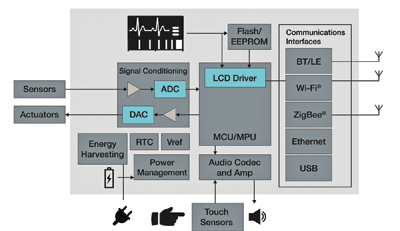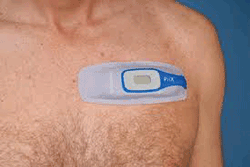Semiconductor advances shape new medical devices
Next-generation medical devices will be smarter, more accurate, and better connected
BY DAVID NIEWOLNY
Medical Product Marketing Manager
Freescale Semiconductor
www.freescale.com
The healthcare industry is in the middle of a technology revolution, and at the same time, rising health care costs and an aging population are straining the world’s health care infrastructure. To accommodate the significant population shift of baby boomers becoming senior citizens, big changes in our health systems are necessary. These changes include new therapies and early diagnostic tools only now being made available by advanced hardware and software, that may previously have been avoided by the risk adverse medical device community. What technologies are paving the way for the medical devices of tomorrow?

Fig. 1: Standard medical device architecture
Figure 1 shows the hardware architecture of a typical medical device. Advances in silicon technology driving innovation in analog signal conditioning, low-power embedded control, and wireless connectivity. Silicon providers are delivering key advances in these strategic areas that are needed by healthcare device manufactures to optimize their products.
Advancing analog
One of the important and unique characteristics of a medical device is the ability to analyze a very-low-amplitude data signal captured by sensor. Advances in precision analog components such as op amps, high-resolution A/D and D/A converters, analog comparators, and voltage references pave the way for increased accuracy on next generation medical devices.
Designers should be looking for a feature–rich, very-low-power A/Ds with greater than 16 bits of resolution. A/Ds that provide up to 24-bits of resolution are available. Many of the newer A/D’s have automatic compare and flexible conversion time settings, which are ideal for this type of analysis. On-chip integration of analog functions provides many system cost benefits. The obvious benefit is that it decreases the need for external ICs and reduces the BOM and the board space. But on-chip analog also features low-voltage detection and internal bandgap reference voltages, which further lowers cost.
Cutting power
Lowering power consumption is another area where advances in semiconductor design are making a significant impact in healthcare. The microcontroller is the central component that performs most—if not all—of the application tasks. Making optimum use of the MCU’s features is essential to achieving battery life targets. Whether on the shelf, in a standby mode, or performing measurements, having certain capabilities can affect battery lifetime and go a long way toward determining the value of a product to the end customer.
Semiconductor manufacturers are taking steps to lower MCU power via some innovative design techniques. The first, is additional modes of operation. Each low-power mode is tailored to a specific level of functionality to allow the most efficient performance/power consumption tradeoffs. The standby modes of operation support power consumption as low as 250 nA for some MCUs. The modes of operation also enable many of the MCU’s peripherals to operate in a low–power run mode to provide the right mix of functionality and power consumption.
Another design technique is clock gating, which shuts down the clock signal that is routed to a peripheral. Though clock gating a single peripheral may only reduce power by tens of ua, when reaching for the lowest power possible, it is essential to quiet every unneeded trace and clock signal. Clock gating can often reduce run mode power by a third.
The third low-power technique is the creation of a separate power domain. Each memory bit cell and I/O driver has a leakage current. The larger the MCU memory and I/O count, the greater the leakage. Separate power domains are used to power only a subset of the MCU features needed to perform timekeeping the crystal oscillator and real time clock registers.
All the low-power design techniques discussed have been implemented on Freescale’s Kinetis line of microcontrollers and microprocessors. Used together, the features described can optimize a medical design for more energy efficient operation.
Wireless medical devices
Despite the fact that wireless technology is becoming pervasive in many aspects of daily life, most medical devices are still wired today. Often a data collection sensor is wired to the medical device and that unit is then connected to a PC, via another wired connection, likely USB. These wired solutions cause numerous issues for the patient, most importantly is ease of use. Electrocardiogram readings often require 16-leads, which means the patient is covered in sensors and wire and the test may not suitable for home use. Figure 2 shows a next-generation, Band-Aid-sized ECG wireless sensor.

Fig. 2: ECG data collection device (near future).
Medical device designers have a wide variety of options when it comes to choosing a wireless protocol. The primary wireless protocols are listed in Table 1 .
| Table 1: Wireless standards commonly used in medical applications | ||||
| Wireless Standard | Raw Data Rate (kbits/s) | Range (m) | Battery Life (years) | Frequency |
| ANT/ANT+ | 1,000 | 30 | >2 | 2.40 GHz |
| Bluetooth Smart (BLE) | 1,000 | 10 | >2 | 2.40 GHz |
| ZigBee | 250 | 100 | >2 | 2.40 GHz, 915 MHz, 868 MHz |
| MBAN (802.15.6) | 1,000 | 10 | NA | 2.36 to 2.40 GHz |
Table 1: Wireless standards commonly used in medical applications
As you can see, a wide variety of low-power technologies are available for use in wireless medical devices and each has their place. ANT/ANT+ is a proprietary 2.4-GHz protocol currently used mainly in health and fitness products, not clinical medical equipment. The total volume of ANT-enabled products is rapidly growing, but only a handful of products have adopted the technology, potentially due to the low burst-transfer rate of 20 kbits/s.
Similar to ANT, ZigBee operates in the 2.4-GHz space and has gained some adoption in the medical device space, largely due to its specific healthcare profiles. One key difference is that ZigBee is built on an open-standard protocol (IEEE 802.15.4) rather than a proprietary protocol like ANT. ZigBee success has been within clinical environments where hospital IT professionals are able to take advantage of its mesh networking capability.
Bluetooth Smart handles short-range, low-energy applications where only short bursts of data are required. Low latency and numerous available sleep modes allow to boast of low-power-consumption characteristics. These characteristics combined with the fact that Bluetooth 4.0, containing Bluetooth Smart/Bluetooth Low Energy has become standard in a number of mobile devices.
A new wireless protocol that is well positioned for rapid market adoption is the Medical Body Area Network or MBAN protocol. The MBAN spectrum was developed for use in low-power and short-range medical applications and has been driven by the “last meter” challenge of untethering the patient from the bedside monitoring and treatment equipment. It operates using the IEEE 802.15.6 Body Area Networks standard and may be able to use the same radio hardware as ZigBee or Bluetooth Smart. Silicon providers have begun establishing solutions, some of which will launch in 2012.
Product longevity
One last point to be considered is that, unlike many other electronic products, medical devices face a heavy premarket regulatory burden. Even in the best of circumstances, the development of medical devices is expensive and the time to market is long. This necessitates a need for products with a 10 to 15-year product life. Silicon providers have taken notice, and some have introduced programs that guarantee a product’s life for 10, 15, or even 20 years. You can find a list of Freescale devises with extended life cycles at www.freescale.com/productlongevity. ■
Advertisement
Learn more about Freescale Semiconductor





